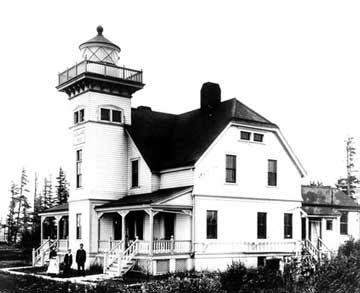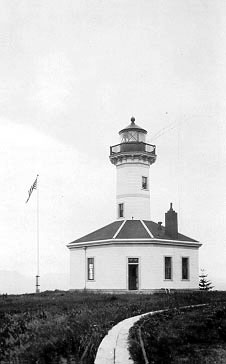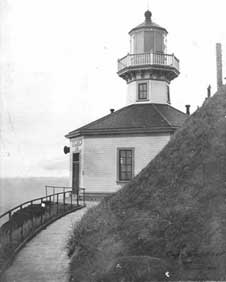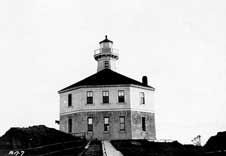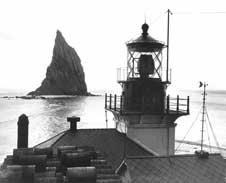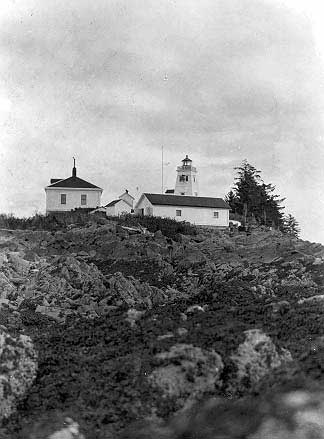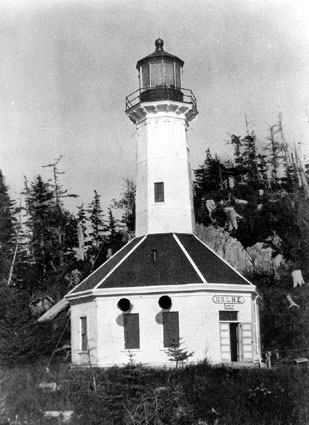 For Safer Southeast Maritime Travel By DAVE KIFFER November 06, 2009
In some places, like Wrangell and Sergius narrows, dozens of blinking aids to navigation now light the way like Christmas bulbs strung to lead ships to safety. But in other areas, like the wide expanses of Clarence or Chatham straits, you can sail dozens of miles without seeing a single light. Except for the lighthouses, the beacons of safety that the United States finally established in Alaska in the early 1900s, after the unregulated maritime chaos of the Klondike Gold Rush of 1897-99 led to hundreds of marine accidents in Alaska in a two-year period. 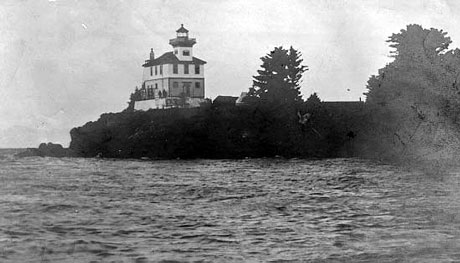 The first two lighthouses to be built were Five Fingers, at the confluence of Frederick Sound and Stephens Passage south of Juneau and Sentinel Island just north of Juneau in Lynn Canal.. Both lighthouses were "lit" on March 1, 1902. Photograph courtesy United States Coast Guard
"The Russian American Company suffered terrible losses of ships and men on the perilous voyages from Siberia to its headquarters, eventually established at Sitka in Southeastern Alaska," Lowry wrote. "With the exception of a small whale-oil lantern placed in the cupola atop Baranof's Castle at Sitka around 1834, toward the end of Russian rule, no lights illuminated the brutal shores of Alaska." Not much changed when American took control of the territory in 1867.
That year George Davidson of the United States Coastal Survey made an extensive survey of the Alaskan coast and recommended, in 1869, that two lighthouses be built in Sitka, two more near Kodiak, and two at Dutch Harbor in the Aleutians. In his report to President Andrew Johnson, he noted that hundreds of ships had gone aground in Alaskan waters. He also recommended that hundreds of other buoys, lights and other markers be deployed along the coast. "Congress quietly shelved Davidson's report and took no action to reserve Alaskan lands for lighthouses," Lowry wrote. "At that point in American history, legislators and the eastern political establishment regarded the Alaska acquisition as pure folly." Lighthouse Board Saw Need for Aids To Navigation But if Congress was not interested, the federal Lighthouse Board, did take Davidson's report seriously. The board continued to investigate the hazards to navigation in Alaska, primarily by using the buoys and other non-lit markers that the Russians had left in Alaska. "The only lighted aid, the whale oil lantern (in Sitka), was transferred to the jurisdiction of the Lighthouse Board and maintained for a time by a lone keeper who earned 40 cents per day for the task," Lowry wrote. The Sitka lighthouse keeper stayed on until 1877, when the US Army ended its Alaska stay and the "light" was extinguished for the next two decades. In 1880, the discovery of gold in Juneau boosted interest in travel to Alaska, and the Lighthouse Board authorized 14 iron navigation buoys in Southeast Alaska, although it still took several years for Congress to approve the funding for the buoys. Another gold strike in the Alaskan interior near Fortymile in 1886, in addition to the growth in Alaska's salmon canning industry put additional pressure on the federal government and more buoys were placed. "With the wreck of their steamer Eureka in Peril Strait (near Sitka) in 1883, Pacific Steamship Company officials even offered free transport for government buoys to Alaska, supporting their urgent request to the board by listing dozens of marine hazards in Tongass Narrows and Wrangell Narrows," Lowry wrote.
By 1890, there were 27 buoys and 15 "daymarks" in Alaska, according to the 1974 "Aids to Navigation in Alaska History" report by the state of Alaska. By, 1895, that number had grown to 57 buoys and 26 daymarks. And there was one "lighthouse," a single "lit" light post on top of Castle - or Baranof - Hill in Sitka. The "castle" had burned down in 1894, but the light had been replaced. The first tender of the first official light in Alaska, was William Marrett, according a story in the June 22, 1895 issue of the Alaskan newspaper. The next site that tried to get a light, was the customs house at Mary Island south of Ketchikan. As the official entry point for vessels coming into the territory, the Lighthouse Board petitioned Congress to fund a lighthouse at Mary Island in 1892, but Congress said no, according to the 1974 state report. Klondike Rush Dramatically Boosted Marine Traffic To Alaska Then came the Klondike rush and just about any object that could float sailed north from Seattle to Alaska. Dozens of barely seaworthy craft, piloted by inexperienced sailors ran aground or sank in the open ocean on their way north. Although it is impossible to know the precise human toll, some historians have estimated that up 1,000 people perished in boat accidents on their way to the Klondike. Congress finally got the message and in June of 1900, it appropriated $100,000 for light stations in Alaska. The first two lighthouses to be built were Five Fingers, at the confluence of Frederick Sound and Stephens Passage south of Juneau (Petersburg had not yet been founded) and Sentinel Island just north of Juneau in Lynn Canal.. Both lighthouses were "lit" on March 1, 1902. Next up was Scotch Cap near Unimak Pass in the Aleutians on June 18, 1903 followed by Mary Island, south of Ketchikan, on July 15 of the same year. In December of 1903, Lincoln Rock in northern Clarence Strait went on line. The year 1904 saw six more lighthouses go begin operating in Alaska. Tree Point (near the Canadian border), Cape Sarichef (also in Unimak Pass), Fairway Island (Chatham Strait), Guard Island (north of Tongass Narrows), Point Retreat (on Admiralty Island near Juneau) and Point Sherman (In Lynn Canal). By 1905, there were 15 lighted signals (including the 11 light houses), eight fog signals, 68 buoys and 30 daymarks in Alaska. At that point the frenzy to "light" the Inside Passage died down a little bit. Eventually five more lighthouses would be built in Alaska. Eldred Rock in Lynn Canal went on line in June of 1906, Cape Hinchinbrook (in Prince William Sound) in 1910, Cape St. Elias (also in Prince William Sound) in 1916, Cape Spencer (in Cross Sound) in 1925 and Cape Decision (at the mouth of Chatham Strait) in 1932. By 1940, there were 457 lights (including 16 lighthouses), 15 fog signals, 316 buoys, 181 day marks and 9 radio beacons in Alaska. Of course, the aids to navigation themselves were only half the story. Alaskan Lighthouses Had Keepers Through The Early 1970s For more than half a century, the lighthouses of Alaska were manned with lighthouse crews, with all the lights finally being automated in the 1960s and early 1970s. In addition to keeping the lighthouses working, those crew became isolated outposts of humanity in the vast empty expanses of the Alaska coastline. They also provided remote lifesaving stations along the coast. Here are some historical tidbits about some of the Southeast lighthouses. Guard Island - This sentinel lighthouse is the only one visible from the Ketchikan road system and "guards" the northern approach to Tongass Narrows. Guard Island was one of the few Alaska lighthouses that had enough space for family quarters and often had two keeper families on site. "During the early part of this (20th) century, Guard Island's two families were best known for their bickering and petty grievances against one another," Lowry wrote in 1992. "Escalating tensions led in one case to jealousy and murder. An assistant keeper on leave with his wife apparently discovered that she had been having a love after with the head keep(er). She was found murdered in a Seattle hotel room." The island's remote location from Ketchikan also led to other famous incidents, such as one in which the keeper was looking through his binoculars and witnessed a fishermen get murdered and dumped overboard on a fishing boat near Gravina Island.
Another Prohibition era incident led to the lighthouse keepers discovering two murdered men on board a trolling boat that nearly ran aground on the island. Guard Island was also well known for the deer that frequently lived on the island and its smaller neighbor. The deer were so tame because they were often tended to and fed by the keepers and their families. Eldred Rock - Eldred Rock in Lynn Canal became a light station after one of the most mysterious sinkings in Alaska history. In 1898, the steamer Clara Nevada apparently ran aground on the rock. It had 100 passengers and an estimated $100,000 in gold on board. It was also apparently carrying a large load of dynamite, against regulations. Only one body was recovered, that of the purser George Foster Beck. The sinking spurred the government to put a light on Eldred Rock, which it did eight years latter. Two years after the lighthouse was built, another storm thundered down the canal. Wind died down, the wreck of the Clara Nevada, was back on the island, it's remains, and that of the some of the missing passengers, scattered on the beach. But that night, another storm blew in and it returned to the depths surrounded the rock. The gold on the ship, by the way, was recovered and some speculate that one of the crew members survived and took the gold with him. Interestingly enough, Eldred Rock lighthouse still has the original octagon design that nearly all the lighthouses in Alaska originally had. Cape Spencer - Cape Spencer had the first radio beacon when it was completed in the mid 1920s, reportedly reaching ships some two hundred miles out to sea. It was also one of the most remote sites, some 150 miles from the nearest town of any size. Lowry wrote that even the physical access to the station itself was a challenge with visitors having to jump from a small boat into a basket that was then lifted by a large crane some 80 feet above to the water to the station. It was a "thrilling" ride even the calmest of weather. 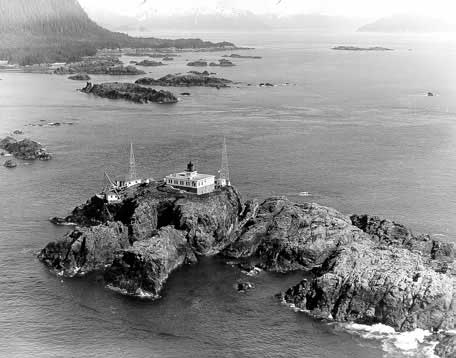 Date Unknown Photograph courtesy United States Coast Guard The extreme weather patterns in Cross Sound/Icy Strait often caused unusual occurrences, according to Lowry. She quoted one former keeper telling a story about a night when the light beams got refracted by the mist and caused a gigantic flock of birds to begin circling the tower. "The beams of light were so heavy with them (the birds) it looked like a blizzard in the reflected light," Pat O'Brien told Lowry. "You could hit them with a stick, if you opened the door, the room would fill with birds." The next day, the keepers found the station covered by hundreds of dead birds that had flown into the light in their confusion. Cape Decision - Cape Decision was the last lighthouse built in Alaska, and was built primarily because of concerns raised the by the owners of the dozens of canneries built in the 1920s in Chatham Strait, Sumner Strait and the west coast of Prince of Wales Island. One of the largest stations, it had room for three keepers. 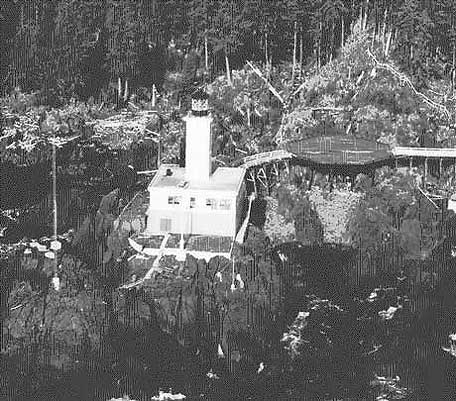 Date Unknown Photograph courtesy United States Coast Guard Like most of the lighthouses, it was not always safe to land supplies at the lighthouse. In the case of Cape Decision it was often easier to land at McArthur Bay, eight miles away. Because of its isolation, it also had the reputation as a place where the keepers were frequently "lit" up themselves, according to the stories related by Lowry. The situation was further exacerbated by the light's relative closeness to Port Alexander which had a reputation as the "homebrew" capital of Southeast Alaska.
Tree Point - The only lighthouse in Alaska to be actually built on the mainland, the Tree Point Lighthouse is primarily known for something that allegedly happened nearby. When Ketchikan was a small mining village before the turn of the 20th Century, a miner came into Ketchikan with a very large amount of gold. All he would tell the residents was that it came from Tree Point. But numerous attempt to track either the miner - who was never seen again - or find his mother lode were unsuccessful. Later, after the light was established, two different keepers found evidence of a mine site while hunting at different times in the hills behind the lighthouse. But the terraine was so convoluted that neither was ever able to locate the mine again. Then again, events that happened at the lighthouse could also be noteworthy such as this anecdote about Tree Point at the website lighthousefriends.com. "And conditions at the station appear to have been far from normal. When the officer-in-charge (OIC) announced that he would no longer be taking his six-hour turn at the radio watches, an enraged subordinate spent the following night getting drunk on a bottle of whiskey he had smuggled to the station. The OIC put the fellow on report, but then had to lock himself in the lighthouse for safety as the madman bellowed taunts at him from the hill behind the tower and then "split the top panel of the lighthouse door with a broad head hunting arrow" shot from his seventy-pound lemon-wood hunting bow. The OIC radioed to Ketchikan for help, and a few hours later an investigation party, armed with a pistol and a rifle, arrived on an eighty-three footer." Mary Island - The Mary Island light was once expected to perform a more important mission that it does today. At one point, federal officials expected that the area of Revillagigedo Channel where the light is located would be the main entryway for Alaska. In 1892, a customs house to handle ship traffic from British Columbia into Alaska was built and the Lighthouse Board immediately petition Congress to provide a lighthouse. But the lighthouse was late in coming and by the time if finally did, 1903, the customs house had already been moved into the small community of Ketchikan, some 30 miles to the north. So other than the keeper families quarters, nothing much developed on Mary Island. Sadly, there is one reminder of the Mary Island lighthouse community, other than the light tower itself. The grave of Edward Pierce, the young son of one of the early keepers, is on a bluff south of the station. He died, reportedly, because bad weather prevented him from leaving the island for treatment of an unspecified illness.
Editor's note: "Northern Lights," an exhibit about the lighthouses of Alaska is on display at the Tongass Historical Museum in Ketchikan through Nov. 15. Also, for a story about what it was like for a family to live on Guard Island in the 1950s, see "Lighthouse Family Returns To Guard Island," SITNEWS, Sept. 19. 2006
Dave Kiffer is a freelance writer living in Ketchikan, Alaska. He is also currently the Ketchikan Gateway Borough Mayor. To republish this article, the author requires a publication fee. Contact Dave at dave@sitnews.us Dave Kiffer ©2009
|
|||||
